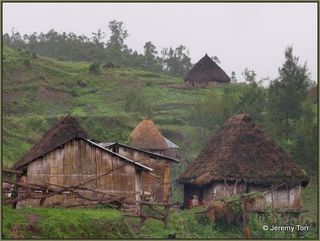Climate Change is changing our weather. But what are the knock-on effects for forests and woodlands? Here are edited extracts from: “Adaptation of Forests and People to Climate Change” from Dr. Balgis Osman-Elasha, lead author for International Union of Forest Research Organizations (IUFRO).
 As woodlands change in line with changing global climates, there is no doubt that many poorer people living in close contact with forests will be most severely affected.
As woodlands change in line with changing global climates, there is no doubt that many poorer people living in close contact with forests will be most severely affected.
United States, 20 January 2010. Greenhouse gas emissions are the main anthropogenic cause of current climate change. The magnitude of future change will be affected by the extent to which these emissions are reduced. Regardless of climate change mitigation activities implemented today or in the near future, however, historical emissions and inertia in the climate system mean that further climate changes are inevitable.
Forests, and the goods and services they provide, are essential for human well-being. An assessment of the likely impacts of climate change on forests is important for effective climate change adaptation.
Forest ecosystems provide a wide range of ‘ecosystem services’. Together with existing socioeconomic processes (e.g. deforestation, forest fragmentation, habitat loss, population growth, income growth and urbanisation) climate change could lead to significant changes in the delivery of forest services such as timber, food, shelter, animal sanctuary, terrain conservation.
Sustainable forest management should maintain and enhance the economic, social and environmental values of all types of forest. Sustainable forest management, therefore, can play an important role in climate change adaptation. At present, however, many forests are not managed sustainably.
Where Now?
Forest stakeholders at the international, national and local levels need to agree on appropriate measures and policies. This will require a change from traditional top-down approaches towards information sharing, transparent decision-making, accountability, well-defined property rights and collaboration between stakeholders. Research on forest adaptation to climate change is relatively recent; while many promising examples exist, only a few studies have documented successful adaptation strategies.
 People dwelling in remote places rely on forests for their livelihood.
People dwelling in remote places rely on forests for their livelihood.
Climate change, however, appears to be progressing too quickly for decisions to be delayed pending the outcome of future studies. Irrespective of the uncertainties, societies can (and indeed must) make climate change mitigation and adaptation decisions now.
Throughout human history, forest clearing for agriculture and other purposes has been a dominant factor in determining the extent and condition of forests. Invasive species are also having a dramatic effect on forest ecosystems. The expansion of global trade in forest products has stimulated plantations and wood-processing plants, particularly in developing countries and in most areas global warming has had limited consequences for the forestry sector.
 While actual numbers of trees - and growth rates - may increase, the big picture for cultivated forests is not positive.
While actual numbers of trees - and growth rates - may increase, the big picture for cultivated forests is not positive.
In mid-latitude and high-latitude forests, for example, climate warming is generally lengthening the growing season and increasing tree growth rates. On the other hand, warming is also increasing biotic disturbance and increasing both the activity and demographic of already-present pest species - and the probability of invasion by non-indigenous herbivores, pathogens and plants.
Even so, according to projections by the Intergovernmental Panel on Climate Change (IPCC) climate change is projected to bring noticeable change to the distribution of forest types and species. Globally, it is likely all forest ecosystems will have difficulty adapting to the impacts of climate change. In semi-arid and arid climates, productivity could decline to the extent that forests are no longer viable. They will simply vanish.
Under most scenarios, temperate forests are likely to be less affected than other forest types but large regional risks remain. Productivity is likely to increase in some areas but increasingly prevalent storms could cause major disturbances. Droughts are projected to become more intense and frequent in subtropical and southern temperate forests, especially in the western United States, northern China, southern Europe, the Mediterranean and Australia. These droughts will also increase the likelihood of fire and predispose large areas of forest to pests and pathogens.

One thing is certain - more research and data on forests and their growth is urgently needed.
The IPCC estimates that roughly 20–30% of vascular plants and higher animals are at an increasingly high risk of extinction as temperatures increase by 2–3°C above pre-industrial levels. The estimates for tropical forests exceed these global averages.
Not just the Wood and Trees
Since climate change is expected to have significant impacts on the capacity of forests to provide vital ecosystem services, it could have far-reaching consequences for the well-being of people living there.
In the long term, climate change could increase the global supply of timber, although this will vary. An expansion of global timber output is likely to lead to a reduction in timber prices; in some regions this will have negative effects on timber producers. Regions that are likely to be particularly susceptible over the next 50 years are North America, Europe, Australia and New Zealand. However, output in some areas could decline due to the climate-induced dieback of existing trees and lower investment due to lower prices.
In all scenarios and across all main forest types it is very likely that the frequency and intensity of storms, fire, insect attack and disease will change, with increases in some areas. The mitigation of undesirable impacts will require extensive communication networks and monitoring schemes at the regional and national levels, as well as specific management practices (e.g. controlled burning and sanitary cuts) at the local level.
In regions with large forest-dependent populations, like Africa, expected decreases in rainfall and increases in drought are likely to impose additional stresses. A decline in forest ecosystems means reduced basic needs like food, clean water and other necessities. This can lead to deepening poverty, deteriorating public health and social conflict.
Forests also provide many spiritual, aesthetic and recreational benefits; climate change adaptation responses, therefore, should take these into account. Few data are available, however, on the impacts of climate change on the cultural and spiritual values associated with forests - or on recreation and ecotourism.
 In North America, it is likely that the overal size of forests will shrink, partly thanks to predations of newly-aggressive pests thriving in warmer conditions.
In North America, it is likely that the overal size of forests will shrink, partly thanks to predations of newly-aggressive pests thriving in warmer conditions.
How are we Coping?
These issues will all demand considerable investments in infrastructure (e.g. communications, fire detection and transport), training and equipment. A laissez-faire approach to global forest management is inappropriate for effective climate change adaptation.
A failure to take action now is likely to result in increased costs in the future. Forest managers need to be proactive, imaginative and adaptable. The need for more management implies additional costs.
However, traditional forms of forest governance that focus on hierarchical, top-down policy formulation and implementation and the use of regulatory policy are not flexible enough to meet the challenges of climate change.
Moreover, policies in other sectors, especially agriculture, transportation and resource development will continue to have significant impacts on forests, requiring improved inter-sectoral coordination that is difficult to achieve through this kind of top-down policy-making.
Current action at the international level consists of a number of poorly coordinated programmes directed mainly at reducing deforestation and mitigating climate change - rather than at addressing the full range of climate-change adaptation issues and options.
Additionally, policies should not ignore the many drivers of forest change that originate in other sectors: agriculture, energy (e.g. biofuel crops), transportation, conservation can all have dramatic effects on the incentives to destroy or degrade forests.
Saving the forests in the face of climate change is a major task; one that needs co-ordinated effort.
Key Messages
- The carbon-regulating services of forests are at risk of being lost entirely unless current carbon emissions are reduced substantially.
- The impacts of climate change on forests will have far-reaching social and economic consequences, particularly the forest dependent poor. Adaptation measures must go beyond technical solutions and address the human institutional issues too.
- Sustainable forest management is essential for reducing the vulnerability of forests. The current failure to implement it limits the capacity of forests and forest-dependent people to adapt to climate change at both international and national levels.
- Flexible approaches to policy are needed that are sensitive to context and do not rely on a single, one-size-fits-all mechanism. New modes of governance are required that enable stakeholder participation and provide secure land tenure and forest user rights. More research is required but despite the limitations of current knowledge, climate change is moving too quickly to postpone action pending outcomes of future studies.
- Unmitigated climate change will most likely exceed the adaptive capacity of many forests. Large reductions in greenhouse gas emissions from fossil fuels and deforestation are urgently needed.
Photos by Jeremy Torr